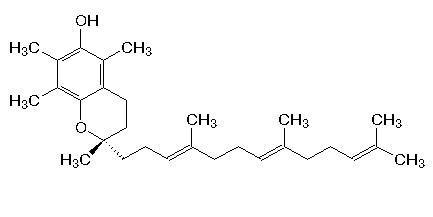Contents
What does vitamin E do in the body?
Vitamin E is a powerful fat soluble antioxidant, which can be incorporated into the membrane of our cells; once there it can neutralise free radicals which would otherwise damage the cell. Once oxidised, vitamin E can be recycled by water soluble vitamin C, – allow vitamin E to continue protecting the cell.
Vitamin E can also help to regulate the expression of various genes, particularly those involved in muscle growth. There is also evidence to suggest that vitamin E is needed for many neurological functions, as a deficiency of vitamin E is characterised by the onset of neurological dysfunction such as myopathies as well as a weak immune system. The protection of neurological function is now being largely attributed to the tocotrienol sub-group of vitamin E. whereas the role of protecting other cells in largely fulfilled by the vitamin E sub-group tocopherols. As the 2 distinct groups of vitamin E seem to offer different benefits with regards to their role in protecting cells, a vitamin E supplement may not be enough to combat vitamin E deficiency, as vitamin E in supplements is generally in for for of alpha-tocopherol, and rarely contains totocreinols.
Foods high in Vitamin E
Vitamin E is most abundant in plants, and only low amounts are found in animal products. Nuts contain some of the highest amounts of vitamin E, particularly almonds, which 20g providing nearly 50% or your RDA. Vegetables such as tomatoes and spinach also contain significant amounts of vitamin E, and often you will find cereals are fortified with vitamin E.
How much Vitamin E do you need?
The UK guidelines for vitamin E are 3mg for women and 4mg for men, however, to be healthy you are likely to need more than this as the RDAs are based on the minimum requirements, not optimum requirements. There is no figure for the optimum requirements, and in reality the amount you need to be healthy will vary from person to person. Fortunately, due to its fat solubility, deficiency of vitamin E is rare, but if you are concerned about getting enough vitamin E and handful of nuts/ seeds a day will provide more than the minimum amount required.
The chemistry of Vitamin E
Below is the molecular structure of a tocotrienol vitamin E molecule. (All vitamin E molecules contain the same basic structure).

There are 2 important aspects of this molecule which allow it to fulfil its functions in the body. The first is the hydrocarbon tail (extending to the right), and the second is hydroxyl groups (OH) on the left of the molecule The hydrocarbon tail allows the molecule to be fat soluble, and it is this tail which embeds into the phospholipid cell membrane, allowing it to be stored and protect the cell.
The hydroxyl group gives vitamin E its anti-oxidant properties, and allows it to react and neutralise harmful radicals species. This is achieved by ‘donating’ a hydrogen ion to the radical which makes it less reactive. If vitamin C comes into contact with a vitamin E molecule which has reacted with a free radical, vitamin C will ‘donate’ one of its hydrogen molecules to Vitamin E, allowing it to continue to protect the cell.
Summary
Vitamin E is an essential vitamin, which plays a vital role in protecting our body from oxidative stress. With this in mind, it is a reasonable assumption that vitamin E will help protect against the development of cancer and inflammation. As vitamin E is fat soluble, our body is able to store it, so a daily supply is not needed, although it is advisable. The best sources of vitamin E are usually plant based foods which are high in fat, such as nuts and seeds.

